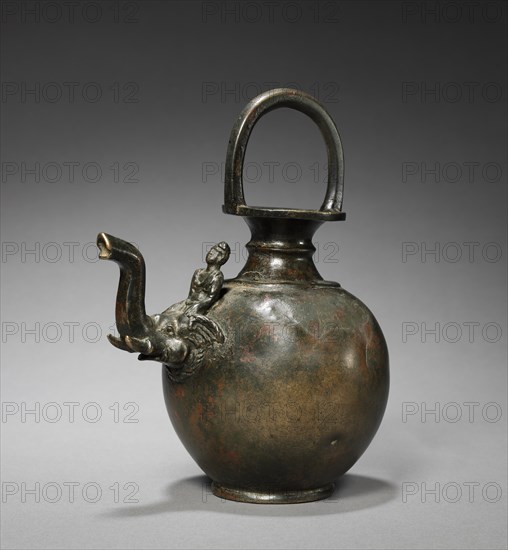
Sujet
Ewer with Spout in the Form of an Elephant with a Mahut, c. 1st Century. Creator: Unknown.
Légende
Ewer with Spout in the Form of an Elephant with a Mahut, c. 1st Century. This bulbous-shaped ewer with a low foot, narrow neck, and a loop handle attached to the top of the neck is cast in one piece. The neck, with an overhanging rim that widens at the mouth, is decorated with moldings at the bottom and in the center. The loop handle is octagonal in cross-section. Most interesting is the spout in the form of an elephant's head with a raised trunk and a mahout seated on its neck. The costume and turban worn by the rider are Kusana, while the elephant is indigenous to the region. Similar vessel shapes are commonly found in the Hellenistic world around the time of the Christian era; therefore, it is not surprising to find them within the sphere of Gandharan influence, which took its inspiration from the classical West. Among Sir John Marshall's excavations in Taxila, vessels of this type were found. Marshall suggested that the ewer with a loop handle at the top belongs to the category of traditional Indian vessels, while one with the handle on the side follows Greco-Roman prototypes. Similarly, the metal ewers excavated by Marshall were found in later strata in Sirkap and date to the first century AD, or even earlier. However, the earlier type seems to be the one with the vertical spout, so that the type of spout represented here probably dates later, around the first century AD. Furthermore, the elephant spout with Kusana rider suggests a date no earlier than the first century AD. A gold spout in the form of an elephant's head, originally attached to a glass vessel, was found in Begram and is presently at the Kabul Museum. The ewer was damaged when acquired. There were two irregular holes located on the globular sides of the vessel, just below the neck, with surrounding cracks. Although the holes were not very large, the damage was visually disturbing and prompted the restoration. The bottom of the ewer, now missing, was left as is, with no attempt to restore it.
Crédit
Photo12/Heritage Images/Heritage Art
Notre référence
HRM19G20_487
Model release
NA
Property release
NA
Licence
Droits gérés
Format disponible
83,7Mo (4,5Mo) / 44,0cm x 47,6cm / 5202 x 5624 (300dpi)